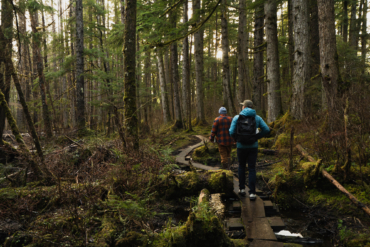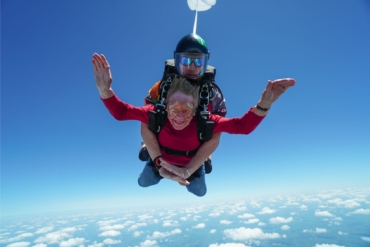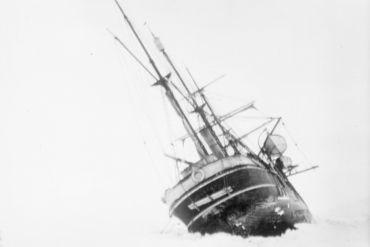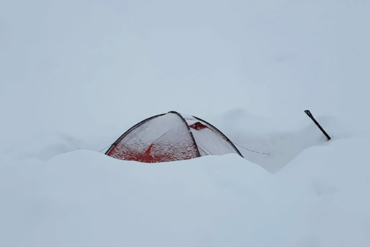Arms pumping, eyes scanning the ground ahead, Dean Laiti runs east on a sidewalk in St. Louis Park, Minn., his feet swishing like sandpaper on cement below. “Right over these tracks,” he shouts, making a quick turn to leap a railroad grade.
It’s a Tuesday evening in early June, and Laiti, a 48-year-old finance worker, has volunteered to teach me to run the way nature intended. That would mean barefoot — without shoes and striding, skin and toes to nothing but asphalt as we bound east toward the skyline of downtown Minneapolis beyond.

Above: Laiti’s calloused feet are the result of thousands of miles run without shoes.
“Watch out for that gravel,” Laiti says, pointing to a bed of rocks beside the path. He runs feet gracing the ground, calloused pads contacting pavement in an almost soundless stride.
I tag behind, feet slapping, wincing as my toes tread on a medium I’ve heretofore reserved for rubber soles.
“You doing ok?” Laiti shouts, looking back.
Barefoot Heritage
Running barefoot was for many millennia the only way to get around, and the human foot — a biomechanical masterpiece of muscles, tendons and 26 bones — evolved to absorb weight and spring bodies in stride.
Historically, when shoes did come into play they were most often minimal, the likes of hide sandals and moccasins, made to insulate in the cold or protect skin from sharp objects beneath.
Then Nike came along.
“The phenomenon of cushioning in running shoes is a recent invention,” said Dr. Paul Langer, a podiatrist and marathon runner in Minneapolis. “We’re now seeing that all the innovations pushed for years by Nike, Adidas, et al., may not be better than a naturally functioning foot.”
Langer, who works at Minnesota Orthopaedic Specialists and is a clinical faculty member at the University of Minnesota Medical School, said misinformation in the 1980s started the myth that cushioning in shoes is always better. “It became more about marketing and less about biomechanics,” he said.
The result was shoes with gel pockets, air pumps, exaggerated arch support and even computer chips. But the innovation backfired with many runners, Langer said, adding weight to shoes and promoting an unnatural gait where the heel — not the forefoot — was made to absorb impact on each stride.
Langer saw injuries ranging from shin splints to tweaked knees, often the maladies originating at least in part from bad form and pavement pounding in shoes that disabled the natural flex of the foot.
Five-Toed Renaissance
Beginning in the last five years — due to new research and consumer demand — companies started selling shoes that give control back to the foot.
Nike’s Free shoe line, as one example, attempts to mimic the manner of a bare sole striking earth, eliminating arch support and reducing heel padding to provide a pliable sole that lets the foot flex.
On the extreme end, Vibram, an Italian company, released its FiveFingers “foot glove” in 2006 with articulated toes and a thin sole.

Above: Vibram’s FiveFingers shoes are one extreme in “barefoot-style” footwear.
With or without shoes on, the technique of landing on your midfoot or forefoot instead of your heels is better on the body say running experts like Langer. “About 80 percent of runners land on their heels while wearing shoes,” he said. “But almost 100 percent of runners will land on their forefoot when going barefoot.”
For Ted McDonald of Seattle, Wash., the forefoot strike was a turning point in his running life. “It was close to a religious experience,” said McDonald, describing his first barefoot jog.
McDonald, 43, had struggled with back pain while running prior to taking his shoes off. But the barefoot style suited him so well that he went on to run several marathons sans shoes and created a website to blog on the topic, barefootted.com.
“The first day I went barefoot was the greatest run of my life,” McDonald said.
Test Run
On my run with Laiti “greatness” did not enter the vocabulary. It started out fine enough, with Laiti running and me following on a bike to get a glimpse of his technique. Then, after abandoning my shoes, I put pink soles to the paved path and followed as Laiti floated away.
A legend of sorts in local running circles, Laiti is known simply as “the barefoot guy,” according to Heidi Keller Miler of the Minnesota Distance Running Association. “He runs workouts, races, marathons — everything barefoot.”
Indeed, it was nearly 30 years ago when Laiti left his shoes behind for a run. “I do it because I can,” said the 115-pound runner. “It psyches people out.”

Above: Laiti in action, running on asphalt during a three-mile training run.
He has trained several nights a week for decades, barefoot on pavement, grass and trails, from April to October most years. Obstacles including searing hot pavement in the summer, goose poop each fall, and glass on race courses have not slowed Laiti down. “I only complain when they re-tar a trail,” he said.
My leap into the barefooting game with Laiti — a 1.5-mile run on pavement and gravel — was perhaps an ambitious first go. We cranked quickly up to pace, running past a power-walking couple who squinted at our naked toes, my feet flapping on the path.
“Feeling anything?” Laiti asked.
I was. With each step my toes and forefeet pricked on grit and gravel. The asphalt was forgiving, smooth-feeling, actually, though bumps, cracks and any aberrations caused tension.
But the gait was easy and efficient, a short, quick stepping on the forefoot with little movement of the ankle and no employment of the heel. Laiti and I started to talk and I temporarily forgot about the situation underfoot.
Always in training mode, this October will mark Laiti’s 27th Twin Cities Marathon — all but a portion of one year’s race done without shoes. He runs shoulders back, confident, feet chalky and calloused from years on the run.
During my initiation run, Laiti and I went three-quarters of a mile before I noticed the blood. A pinky toe, worn through from pavement, dangled sad and injured, a flap of skin signaling my defeat. Pads behind my toes were turning red.

Above: The author’s battered foot after a 1.5-mile barefoot run.
On the phone the following day, I told Dr. Langer about my mishap. He said most podiatrists would not recommend what I had done, listing skin injuries, stress factors and heel spurs as potential results. “I tell people to start gradually if they want to go barefoot and run on grass, never asphalt or cement,” he said.
Sitting in my office, bandaged feet propped up on a chair, I vowed next time to take the doctor’s advice.
(Stephen Regenold writes The Gear Junkie column for eleven U.S. newspapers; see www.THEGEARJUNKIE.com for video gear reviews, a daily blog, and an archive of Regenold’s work.)






